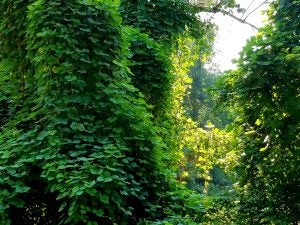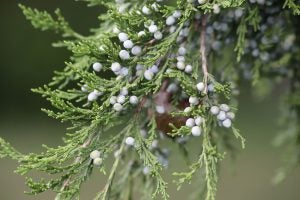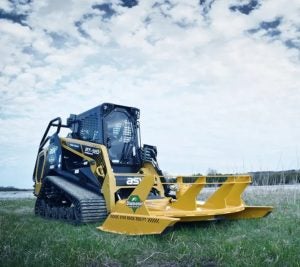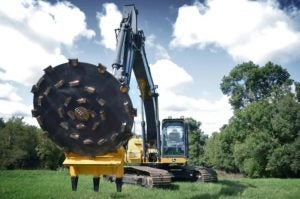When introduced beyond their natural geography, many species of trees and vegetation can infest and degrade land while harming native ecosystems. They have the potential to overtake fields and forests, or even the resources native grasses and vegetation need to live, which results in killing off valuable grazing and production land.
Stringent control and eradication measures are often necessary to minimize the spread of invasive trees and prevent damage to the environment. Fortunately, there are a variety of options for removing these tenacious intruders from your property.
Invasive species by region
Before we dive into the “how” of invasive tree and vegetation management, it’s important to understand the types of vegetation you are likely to encounter. Following is an overview of invasive species you can expect to find in the various regions of the U.S.
Northeast
Invasive Sumac trees can be found across much of the country, but they pose the biggest threat in the northeast and into midwestern states like Ohio and Michigan. Sumac trees grow quickly, aggressively, and in dense thickets. If left unchecked, they can outgrow and displace native vegetation by cutting off access to nutrients and force out wildlife by consuming their natural habitat and/or the vegetation they depend on for survival. Due to their dense foliage, Sumac trees also block rain and sunlight, which brings unwanted changes to the ecosystem’s soil chemistry and temperature.

Southeast
Invasive tree species across the southeastern region of the country include the Brazilian Pepper Tree, Chinese Tallow, Privet, and Saw Palmetto. For reasons that include toxicity, deposition, and invasive root systems, these trees can rapidly overtake natural habitats and reduce the profitability and usability of production land if left unattended. Separately, Kudzu trees cover an area that stretches from Texas to New York. While ideal for shading porches, feeding livestock, and helping to control erosion, Kudzu trees grow quickly and produce vines that cover and kill native plants, envelop trees, snap branches, and climb buildings and powerlines. They can withstand drought, frost, and fire damage and remain dormant for several years before germinating. Therefore, it is crucial to conduct annual maintenance and kill every root crown, which can take several years.
Midwest
The Boxelder is a species of maple with brittle wood and a fast growth system that thrives in wet bottomlands common in the Midwest. While these trees help stabilize stream banks and shelter wildlife, they are considered a weed in many urban areas. Their weak wood causes them to split or drop their limbs in relatively light wind conditions, making them a landscape maintenance nightmare. The Boxelder’s rapid spread can be attributed to how quickly it germinates after dropping its seeds — winged papery fruits that spin through the air and travel great distances away from the parent tree.

Central U.S.
Native to Kansas and originally limited to rocky bluffs, the Eastern Red-Cedar began terrorizing the “central” portion of the U.S. from South Dakota down to Oklahoma and parts of Texas when new land management practices led to a decrease in controlled fires, allowing forests to spread. Because they grow year-round in temperatures above 40 degrees and in a variety of precipitation conditions, these trees damage the surrounding grasslands by intercepting 25 percent to 60 percent of rainfall thanks to their dense canopies, consuming anywhere from six to 16 gallons of water each day, and fueling wildfires because of their flammable foliage, thin bark, and propensity for containing oils.
Northwest
While technically not a tree, Scotch broom is a nuisance in the Pacific Northwest, particularly along the sides of highways. This thick, bushy shrub thrives on sandy, disturbed soil and quickly establishes deep, woody roots. It adds massive amounts of nitrogen to the soil that negatively impacts and changes plant communities. It also produces many seeds, which can last in the soil for up to half a century.

Stopping the spread
In some cases, invasive tree species can be tamed by using chemicals or controlled fires. However, the most effective way for managing overgrowth is through mechanical control, which can be accomplished with the use of skid-steer attachments and a three-step process:
1. Brush cutting
The first step is getting to the source, which typically involves cutting back branches and brush to access the tree’s trunk and roots. The best tool for this job is a brush cutter because this versatile, high-performance skid-steer attachment excels at processing material such as thick grass, brush, and branches. At Diamond Mowers, we offer the Brush Cutter ProX, a rotary mower that features four hydraulic motors for optimal blade performance and safe handling for different types of land and applications with different cutting widths.

2. Mulching
Mulching is the process of grinding trees and brush down into finer material for quick decomposition. For this step, either a disc mulcher or drum mulcher is recommended, and selecting the right attachment for this job is as simple as assessing the size of the trees. Our Forestry Disc Mulcher cuts trees and brush up to 14 inches in diameter and mulches the same vegetation up to 6 inches in diameter while our Drum Mulcher mulches trees and brush up to 9 inches in diameter.
3. Stump grinding
To prevent trees from re-sprouting, you’ll need a stump grinder. This process is typically done after trees have been cut or mulched. Diamond Mowers, for example, offers two types of stump grinders designed to grind stumps of virtually any size to below ground level thanks to their 1-inch-thick heavy-duty wheels equipped with carbide teeth.
You don’t necessarily need all three attachments. A mulcher, for instance, may be sufficient for Steps 1 and 2, depending on the size of the area and the material being cleared.
This article was written by Matt Nelson, product manager at Diamond Mowers. If you have questions about invasive trees and vegetation on your property, consult an arborist or landscaping professional. For more information about equipment related to managing these intruders, visit Diamond Mowers’ website.


